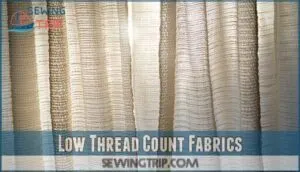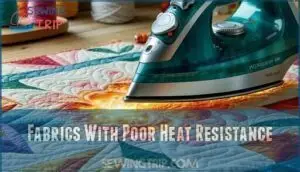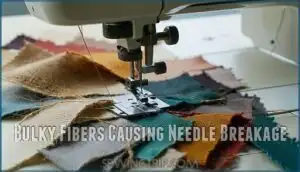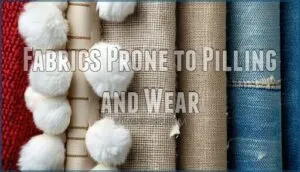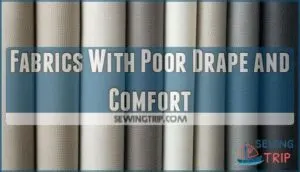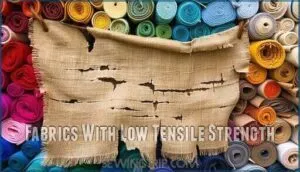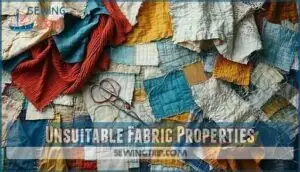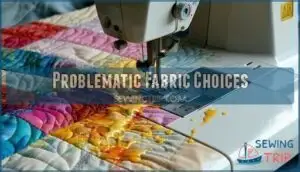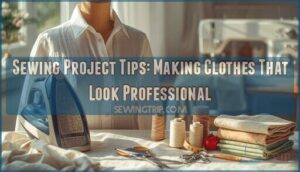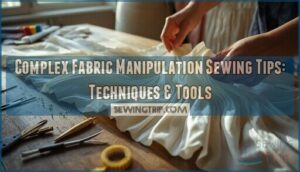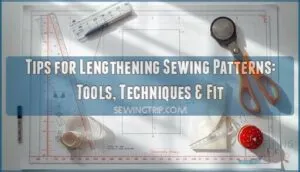This site is supported by our readers. We may earn a commission, at no cost to you, if you purchase through links.
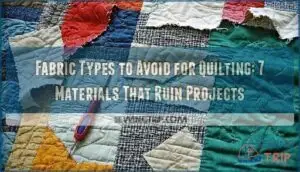
These fabrics distort easily, making precise piecing nearly impossible.
Avoid loose weaves, low thread count cottons, and anything with high elasticity – they’ll shift and fray during handling.
Skip fabrics that pill easily, have poor heat resistance, or require special stabilizers.
Corduroy, heavy denims, and silk blends also spell trouble for most quilting projects.
Fabrics with inconsistent dye acceptance or high shrinkage rates will create headaches later.
The wrong fabric choice can turn your beautiful quilt into a frustrating disaster, but knowing which materials cause the most problems helps you make smarter selections.
This understanding is key to avoiding a quilting project that becomes a frustrating disaster.
Table Of Contents
Key Takeaways
- Avoid stretchy fabrics like knits and jersey – They’ll distort during cutting and create uneven seams that make precise piecing impossible, turning your quilt into a frustrating mess.
- Skip low thread count and loosely woven materials – These fabrics fray easily, lack durability, and create weak spots that compromise your quilt’s structural integrity over time.
- Steer clear of synthetic blends with poor heat resistance – Materials like polyester and rayon can melt under normal ironing temperatures, causing permanent damage and shiny spots on your quilt.
- Don’t use fabrics that pill or have high shrinkage rates – These materials will make your quilt look worn quickly and can cause warping or distortion that ruins hours of careful piecing work.
Fabrics to Avoid Quilting
You’ll save time and frustration by avoiding certain fabrics that can sabotage your quilting projects.
Some materials create problems during cutting, sewing, or finishing that make them unsuitable for quality quilts.
Stretchy Materials Like Knits
Knit fabrics create major quilting challenges through their high elasticity, causing knit distortion and seam unevenness during piecing.
Knit fabrics stretch unpredictably, making precise cuts and even seams nearly impossible for quality quilts.
These stretchy fabric quilting materials shift unpredictably, making accurate cuts impossible. Pilling problems develop quickly with wear, while durability issues plague finished quilts.
Knit fabric quilting requires stabilizers, increasing costs and complexity. Many quilters encounter specific knit challenges during their projects.
Choose stable, woven fabric types instead to avoid these unsuitable quilting fabrics and common quilting fabric mistakes.
Non-Cotton Denims
Non-cotton denims create quilting fabric mistakes that’ll frustrate you.
These unsuitable quilting fabrics weigh up to seven pounds, breaking needles and jamming machines.
Shrinkage issues occur when mixing synthetic blends with cotton, causing puckering. Color bleeding ruins your work, while sewing difficulties arise from thick seams.
Denim alternatives for better quilting durability. To manage this material, consider using heavier sewing needles for best results, and avoid common issues like color bleeding.
Corduroy and Silk Combinations
Mixing corduroy and silk creates a quilting nightmare you’ll want to avoid.
These fabric types bring weight differences that cause uneven seams and structural instability. Corduroy’s bulk paired with silk’s slippery fabric quilting properties creates sewing challenges that frustrate even experienced quilters.
The texture contrast looks appealing but leads to durability concerns and maintenance headaches. Visual harmony suffers when these fabric blends fight each other during construction and use.
For easier handling, consider using Dupioni silk quilting, known for its stability and texture.
Fabric With High Elasticity
High-elasticity fabrics stretch beyond control, creating seam distortion that throws off your entire quilt design.
Stretchy fabrics sabotage your quilt—pieces shift, seams warp, and precision becomes impossible.
These slippery materials shift constantly during cutting, making precise measurements nearly impossible.
Here are four major problems with stretchy fabrics:
- Seam Distortion – Elastic fibers pull and warp seam lines
- Cutting Complications – Fabric stretches while cutting, creating uneven pieces
- Uneven Quilting – Layers shift during stitching, causing puckering
- Durability Issues – Stretched seams weaken over time, reducing quilt lifespan
Fabric Types to Reject
When selecting fabrics for your quilt, certain materials will cause more problems than they’re worth. These fabric types create technical difficulties that can ruin your project’s quality and durability.
Low Thread Count Fabrics
When searching for fabric alternatives, thread count matters more than cost savings.
Fabrics with thread counts below 50 TPI create durability concerns and weave instability.
Avoid quilting fabric that’s too thin or loosely woven—it leads to quilting challenges and project failure.
| Problem | Impact |
|---|---|
| Low thread count (under 50 TPI) | Reduced structural integrity |
| Loosely woven fabric | Excessive stretching at seams |
| Fabric too thin | Poor durability under use |
| Weak fiber bonds | Threads shift during sewing |
| Open weave structure | Fraying and unraveling edges |
The key factors to consider are durability concerns, weave instability, and the potential for quilting challenges.
Fabrics With Poor Heat Resistance
Synthetic fibers like polyester and rayon pose serious ironing damage risks during quilting.
These materials melt at temperatures between 160-260°C, well within standard quilting temperatures.
When you press seams, synthetics can fuse to your iron or distort permanently.
Polyester starts melting around 250°C, while rayon lacks heat resistance entirely.
These pressing concerns make synthetic fabrics unsuitable for quilting projects requiring frequent ironing and precise seam work.
For quilting, it’s important to evaluate fabric weight and GSM for best results, considering the potential ironing damage and the need for precise seam work.
Bulky Fibers Causing Needle Breakage
Thick fabric quilting creates real headaches when heavy fibers overwhelm your sewing machine.
Dense materials like corduroy and heavy canvas demand careful handling to prevent costly equipment damage.
- Needle Size: Use size 16-18 needles for thick fabric quilting projects
- Machine Tension: Adjust tension settings to accommodate fabric bulkiness properly
- Stitch Length: Increase stitch length to reduce strain on fabric needle
- Fabric Thickness: Measure fabric types before starting to avoid machine problems
Quilting Fabric Red Flags
You’ll recognize problem fabrics by their tendency to pill, wear out quickly, and compromise your quilt’s longevity.
These materials also create poor drape and comfort issues, plus they often have weak tensile strength that leads to tears and distortion during construction, affecting the overall longevity.
Fabrics Prone to Pilling and Wear
Fabrics that pill and wear quickly can turn your beautiful quilt into a fuzzy disappointment.
These materials create those annoying little balls on the surface that make your project look old and worn.
| Fabric Type | Pilling Risk |
|---|---|
| Polyester blends | High – retains pills due to fiber strength |
| Acrylic fabrics | Very high – short fibers create rapid pilling |
| Cotton-polyester blends | Moderate to high – mixed fiber rubbing rates |
| Flannel | High – brushed surface releases fibers easily |
| Low-quality wool | High – rough texture and short fiber content |
Pilling causes stem from fiber content and fabric construction.
Synthetic fibers like polyester don’t shed pills naturally, creating permanent surface damage.
Durability testing shows that fabric quality directly impacts fabric lifespan.
Choose tightly woven materials with good wear resistance to maintain fabric integrity and prevent fraying over time.
Fabrics With Poor Drape and Comfort
Choosing fabrics with poor drape creates uncomfortable, stiff quilts that lack the cozy feel you want.
Upholstery fabric quilting often results in rigid projects due to fabric stiffness and limited breathability.
These materials retain oils, develop static issues, and resist blending with cotton, which can lead to problems with the quilt’s overall texture and usability, ultimately affecting its comfort and usability.
Shiny fabric quilting can worsen fabric grain problems, creating uneven fabric texture that compromises comfort and usability in finished quilts.
Fabrics With Low Tensile Strength
When you select weak materials, you’re setting yourself up for disappointment.
Low tensile strength fabrics tear easily during handling and washing, compromising seam durability and fiber integrity.
These materials lack the weave strength needed for long-term fabric lifespan.
Loosely woven fabric falls apart under normal quilting stress, while delicate fabric quilting becomes a nightmare without proper material degradation resistance.
Focus on fabric durability and fabric integrity—your quilt deserves better than materials that can’t handle basic fraying prevention requirements.
To improve fabric stability, consider pre-washing the material before starting.
Unsuitable Fabric Properties
When you’re choosing fabrics for quilting, some materials have structural problems that make them unsuitable for any project.
These fabric properties can cause immediate sewing difficulties and long-term durability issues that compromise your finished quilt.
Open Weave Structure and Fraying
When you encounter loosely woven fabric, you’re facing a quilter’s nightmare. These materials have gaps between threads that create weak spots, making fabric fraying inevitable.
The low weave density means edges unravel constantly during cutting and sewing. Without proper fabric stability, your quilt blocks won’t hold together.
Material selection matters—choose tightly woven options for better fraying prevention and reliable edge finishing. Alternatively, consider materials like felt, which resists fraying completely, providing a solution to the issue of weak spots and ensuring reliable edge finishing.
Inconsistent Dye Acceptance and Coloration
Mixed-fiber fabrics create nightmarish dye problems you can’t fix.
Silk-cotton blends absorb dyes at different rates, causing patchy coloration that ruins your finished quilt.
Poor dye penetration problems plague synthetic blends, creating faded spots and uneven fabric color.
Red and blue fabric types show the worst dye bleeding issues, with up to 30% of quilters experiencing color bleeding disasters.
Dye lot matching becomes impossible when fabrics accept washable dyes inconsistently, and colorfastness issues multiply with fabric pre-treatment mistakes, leaving permanent stains.
Static Buildup and Dust Attraction
Synthetic fabrics like polyester create static buildup that attracts dust and lint to your quilting projects.
This fiber composition problem worsens in low humidity levels, making fabric handling difficult.
The static clings to cutting tools and creates messy work surfaces.
Anti-static sprays provide temporary relief, but proper storage solutions and cleaning methods work better for long-term quilting success.
Problematic Fabric Choices
Some fabrics create major headaches that can destroy hours of careful work.
You’ll want to steer clear of materials with excessive shrinkage rates, those requiring special stabilizers, and fabrics that melt under normal pressing temperatures.
Fabrics With High Shrinkage Rates
High shrinkage rates spell disaster for your quilting projects.
Fabrics with shrinkage percentages exceeding 7% create warping and distortion in finished quilts.
Pre-shrinking methods help identify problematic fabric types before cutting.
Fiber type shrinkage varies substantially—some blends shrink unpredictably compared to pure cotton.
Weave density affects how much fabric contracts during washing, creating uneven quilt surfaces and compromising your careful piecing work.
Natural fibers tighten, causing relaxation and bunching when heated, leading to warping and distortion in the finished quilt, which can be mitigated by understanding fabric contracts.
Fabrics Requiring Stabilizers or Interfacing
When fabrics lack structure, they demand extra support to maintain shape during quilting.
Lightweight fabrics like silk and rayon often shift or pucker without proper backing.
Stabilizers and interfacing add time, cost, and complexity to your project while changing the fabric’s natural drape and feel.
Many quilters rely on silk fabric stabilizer to address these issues.
- Your gorgeous silk pieces become stiff and lifeless with heavy interfacing
- Slippery fabric quilting turns into a frustrating wrestling match with shifting layers
- Loose weaves require multiple stabilizer types, eating into your budget
- Intricate designs become impossible when fabric integrity depends on artificial support
- Design complexity increases dramatically when stabilizers are mandatory for basic sewing
The use of stabilizers can lead to stiff and lifeless fabrics, and slippery fabric quilting can be particularly challenging.
This is why many quilters opt for alternative solutions to maintain the natural integrity of their fabrics, avoiding the need for heavy interfacing and multiple stabilizers, which can be costly and time-consuming.
Fabrics With Low Melting Points and Damage Risk
When selecting quilting fabrics, you’ll want to avoid synthetic fibers with low melting temperatures that can’t handle standard ironing heat.
Polyester and acrylic fabrics melt at temperatures as low as 220°F, causing permanent damage during pressing. These fabric types create puckering and shiny spots that ruin your quilt’s appearance.
You can find various melting fabrics for specialized projects. Always check fiber composition before making fabric choices to guarantee your quilting project survives the heat.
Frequently Asked Questions (FAQs)
What is the best type of fabric for quilting?
Choose 100% cotton quilting fabric with tight weave and high thread count. It’s durable, cuts cleanly, and won’t stretch or fray like other materials during piecing and quilting.
Can you quilt with any type of fabric?
You can’t quilt with just any fabric.
Avoid stretchy materials like knits, jersey, and spandex blends.
They cause distortion, uneven seams, and shrinkage issues that’ll wreck your quilt’s structure and longevity.
Can you make a quilt out of any fabric?
Picture yourself surrounded by a rainbow of fabric choices, each with hidden secrets.
You can’t make quilts from every fabric type.
Stretchy knits, slippery synthetics, and loosely woven materials create headaches with fraying and distortion.
What are the four kinds of fabric in quilting?
The four fabric types in quilting are: quilt top (decorative front layer), batting (insulating middle layer), backing (bottom fabric layer), and binding (edging that finishes seams around the quilt’s perimeter).
Can vintage fabrics be safely used for quilting?
Vintage fabrics can be quilting treasures, but you’ll need to test them first. Check for fabric integrity, colorfastness, and shrinkage before committing to your project for best results.
How do pre-printed panels affect quilt durability?
Pre-printed panels typically use standard quilting cotton with quality matching the manufacturer’s fabric line.
They won’t substantially impact durability if you’re using reputable brands with proper thread counts and construction methods.
Are waterproof fabrics suitable for outdoor quilts?
Waterproof fabrics resist moisture but trap heat and don’t breathe well. They’re slippery, hard to sew, and create bulky seams that compromise quilt drape and comfort for outdoor use.
Do metallic threads damage quilting machine needles?
Yes, metallic threads can damage quilting machine needles.
They’re abrasive and cause faster dulling, increased breakage, and tension problems.
Use metallic-specific needles, reduce speed, and check tension settings frequently for better results.
Should interfaced fabrics be avoided in quilting?
Like those newfangled sewing machines from the 1800s, interfaced fabrics can cause headaches.
You shouldn’t use them because they create bulk, make quilting difficult, and add unnecessary stiffness that ruins your quilt’s drape.
Conclusion
Think of choosing quilting fabric like building a house – you need a solid foundation, not quicksand.
Avoiding problematic fabric types to avoid for quilting saves you countless hours of frustration and guarantees your project’s success.
You’ll prevent warping, pilling, and structural failures by steering clear of stretchy materials, loose weaves, and heat-sensitive fabrics.
Smart fabric selection transforms your quilting experience from a battle into a joy.
- https://www.stickermule.com/custom-stickers
- https://www.createwithclaudia.com/2020/02/tips-for-quilting-with-denim-jeans/
- https://fmquilters.org/tip-of-the-week-overcome-the-challenges-of-denum/
- https://www.quiltingboard.com/main-f1/quilting-denim-question-t311898.html
- https://www.nordiccrafter.com/post/quilting-denim-on-domestic-sewing-machine

